The Best Goat Milk Formula For Babies (2025 Guide)
This post may contain affiliate links. As an Amazon Associate, I earn from qualifying purchases. Please read my disclosure.As a certified nutritionist, health coach, and mom of two, I’ve spent over a decade researching infant nutrition and evaluating formulas. I know that choosing the right baby formula can feel overwhelming, especially when you’re considering goat milk options!
My comprehensive guide reflects my experience and research: it’s your evidence-based, parent-friendly resource to help you decide whether goat milk formula is right for your baby, what to look for and what to avoid, and how to choose which brand is best for your family.

So many of you have come across my best organic baby formula post, and I’m so glad that post has been helpful! One of the most common questions I get when it comes to baby formula is: What about goat milk formula? Is it better than cow’s milk formula? And which one is the best?
And it’s no surprise – goat milk formulas are gaining popularity for a reason. They can be gentler on tiny tummies, are naturally rich in nutrients, and contain A2 milk proteins that may be easier to digest than the A1 proteins found in cow’s milk.
But not all formulas are created equal. That’s why I evaluated every goat milk formula available today, from Europe to the U.S., and created my recommended list of the best goat milk formulas based on ingredient quality, safety standards, digestibility, and real-world results from thousands of parents.
In this guide, you’ll learn:
- When goat milk formula might be a better choice than cow’s milk
- What makes a high-quality goat milk formula (and what to avoid)
- A detailed comparison of the best formulas available today
- Which brands I’d personally trust for my own kids
📝 My Review Process & A Quick Note Before We Dive In
As a nutritionist and board-certified health coach, I base all my recommendations on current scientific research, expert consultations, and my personal experience feeding two formula-fed babies. I have thoroughly vetted every product in this guide, both for ingredient quality and real-world performance. This post has also been medically reviewed and fact checked by Katie Drakeford, MA, RD, CSP, LD, CLC (see my about page for more info about Katie).
This post is for informational purposes only and should not replace medical advice. Every baby is unique, so be sure to speak with your pediatrician before starting or switching formulas. My recommendations are not a substitute for professional medical advice, diagnosis, or treatment.
Some links in this post are affiliate links, which means I may earn a small commission if you purchase through them, at no extra cost to you. I only recommend products I would personally use with my own children. Thank you for supporting this blog and helping me continue to provide science-backed guidance for families like yours!
🐐 What Is Goat Milk Formula?
Goat milk formula is infant formula made from goat’s milk instead of cow’s milk. It’s carefully modified to match the nutritional profile required for babies, including protein, fat, carbs, vitamins, and minerals, so it’s safe for newborns when labeled as an infant formula.
While regular goat milk naturally contains more casein and less lactose than cow milk, it still needs to be processed and fortified to meet your baby’s needs. That’s why the formulas in this guide are different from regular goat milk, they’re specifically designed for infants. (Infants shouldn’t be given regular goat milk or cow’s milk until after 12 months of age).
There are also toddler versions of goat milk formula, meant for children 12 months and up. These can be great for weaning or supplementing a toddler’s diet with extra healthy fats and nutrients, especially for toddlers who are pickier eaters.
I recommend checking labels carefully, because not all goat milk formulas are approved for infants. If you’re unsure, talk to your pediatrician to find the right fit for your baby’s age and digestion
🍼 What Are The Benefits Of Goat Milk Formula?
As a nutritionist and mom, I’ve found that goat milk formula can be a great option, especially for babies who struggle with digesting cow’s milk formula. While it’s not hypoallergenic, goat milk offers several unique benefits that can make it a better choice.
Here’s why some families use it:
- Easier digestion: Goat milk contains mostly A2 casein proteins, which may be gentler on the gut than the A1 proteins found in cow’s milk. It also forms a softer curd in the stomach, which some babies tolerate better.
- Naturally rich in prebiotics: Goat milk is high in oligosaccharides, prebiotics that support healthy gut bacteria, similar to what’s found in breast milk.
- Fewer digestive symptoms: Thanks to smaller fat globules and more medium-chain fatty acids, goat milk is easier to break down, which may reduce gas, spit-up, or constipation in some babies.
- Anti-inflammatory properties: The oligosaccharides in goat milk may also support a stronger immune response and reduce inflammation in the gut.
- Potential for fewer skin reactions: Some studies have found lower rates of eczema in babies fed goat milk formula compared to those on cow’s milk-based formulas.
It’s important to note: These benefits can vary from baby to baby. Goat milk formula isn’t a guaranteed fix, but for the right child, it can make a noticeable difference in digestion and overall comfort For even more details, check out my list of the top 10 benefits of goat milk formula for babies.
🥛 How Is Goat Milk Formula Different From Cow’s Milk Formula?
If your baby isn’t tolerating cow’s milk formula well, goat milk might offer a gentler alternative, but the two types of formula are actually quite similar in overall nutrition. The key differences come down to digestibility and how your baby’s body handles the proteins, fats, and sugars in each milk type.
Here’s how goat milk formula compares:
- A2 vs. A1 Proteins: Goat milk naturally contains more A2 beta-casein, a protein that’s often easier to digest and less likely to cause inflammation than the A1 beta-casein found in most cow’s milk.
- Fat Composition: Goat milk has smaller fat globules and more medium-chain fatty acids, both of which are easier for babies to break down and absorb. This also results in softer curd formation in the stomach, which may reduce discomfort, gas, or constipation in some babies.
- Lactose Content: Goat milk contains slightly less lactose than cow’s milk, which can be helpful for babies with mild lactose sensitivity (though not appropriate for babies with true lactose intolerance).
- Natural Nutrients: Goat milk is naturally rich in vitamin A, calcium, and essential fatty acids, though both goat and cow milk formulas are fortified to match ideal nutrition for infants, regardless of the milk source, so this isn’t a major difference.
- Taste & Texture: Goat milk formula tends to be creamier and mildly sweeter. Some babies love the taste, others may not!
One thing to keep in mind: While goat milk can be easier to digest for many babies, it’s not hypoallergenic and is still considered a dairy formula. Always check with your pediatrician before making a switch, especially if your baby has a diagnosed milk allergy or persistent digestive issues.
For more details on what the pros & cons are of goat milk vs. cow milk formula, check out my guide to goat milk formula vs. cow’s milk formula.
🤔 Is Goat Milk Formula Better For Babies?
In my experience as both a nutritionist and a mom, the short answer is: it depends. Goat milk formula can be a fantastic option for some babies, but it’s not automatically better than cow’s milk formula for everyone.
Here’s what I tell parents when they’re deciding between the two:
- Goat milk formula may be easier to digest for some babies due to its A2 proteins, smaller fat globules, and softer curd formation in the stomach.
- It can be a great alternative if your baby struggles with gas, constipation, or mild digestive discomfort on cow’s milk formula.
- It’s not hypoallergenic. Goat milk still contains dairy proteins and lactose. If your baby has a diagnosed cow’s milk protein allergy (CMPA) or true lactose intolerance, goat milk formula likely isn’t the right fit.
Some babies thrive on goat milk formula from day one. Others may not love the taste or may get constipated on it. And for babies who do well on cow’s milk formula, there’s usually no need to switch.
👉 Bottom line: There’s no universal “best” formula. It comes down to your baby’s individual needs and your pediatrician’s guidance. If cow’s milk formula isn’t working and you want a gentle, nutrient-rich alternative, goat milk formula might be worth trying.
⭐️ Ideal Goat’s Milk Formula Ingredients
As a mom who formula fed my own two kids, I know how overwhelming formula labels can be. But once you know what to look for, and what to avoid, it gets much easier to make a confident choice. Here are the ingredients I prioritize when evaluating goat milk baby formulas:
✅ Organic or Non-GMO Sourcing: Formulas made in the EU or New Zealand typically have stricter organic standards and better animal welfare practices. Holle, Jovie, and HiPP are excellent examples.
✅ Lactose as the Primary Carbohydrate: The main carbohydrate in breast milk is lactose, so I prioritize formulas that also only use lactose. It’s best to avoid added sugars like glucose syrup, corn syrup solids, or maltodextrin.
✅ Balanced Whey-to-Casein Ratio (Ideally 60:40): Goat milk naturally has more casein (about a 20:80 whey:casein ratio), which can be harder to digest. Brands that add extra whey (like Kendamil) make their formula easier on little tummies. Another alternative is for formula brands to add healthy fats and prebiotics, as Jovie does, to aid in smooth digestion despite the whey-to-casein ratio.
✅ Omega-3 & 6 Fatty Acids (DHA & ARA): These support brain and eye development. I look for cold-extracted or non-hexane-sourced DHA wherever possible.
✅ Prebiotics and/or Probiotics: Prebiotics help feed good gut bacteria. Ideally, probiotics are added as well, but you can also supplement with probiotics for formulas that don’t contain it, whereas it is much harder to supplement with prebiotics for infants.
✅ No Highly Processed Additives: I avoid formulas with carrageenan, synthetic preservatives, hexane-extracted ingredients, and soy protein isolate.
✅ Smooth Texture and Easy Mixing: Creamy, lump-free formulas are more palatable and easier to digest.
👉 Note: Some ingredients like palm oil or soy lecithin aren’t ideal but aren’t necessarily deal-breakers. If your formula meets most of the above and works well for your baby, that’s what matters most.
🚫 Ingredients To Avoid In Goat Milk Formula
Over the years, I’ve reviewed dozens of formulas and these are the ingredients I consistently recommend avoiding:
❌ Synthetic DHA & ARA: While DHA and ARA are important nutrients found in breast milk, many formulas use versions extracted with hexane, a chemical solvent. Look for formulas that use non-hexane or water-extracted sources instead.
❌ Genetically Modified Organisms (GMOs): Always look for formulas labeled non-GMO or certified organic, which ensures they’re free from genetically modified ingredients and pesticide residues like glyphosate.
❌ Carrageenan: This thickening agent is banned in Europe for use in infant formula due to its link to gut inflammation (source). Unfortunately, it’s still allowed in the U.S., so double-check labels if you’re buying domestic brands.
❌ Soy Protein Isolate: While soy oil is sometimes necessary, soy protein is more highly processed and may interfere with hormone development in infants when consumed regularly (source).
❌ Palm Oil: Found in many U.S. formulas, palm oil can cause digestive issues and may reduce calcium and fat absorption. While hard to avoid entirely, I consider it a yellow flag, better to skip when possible
🏆 Quick Picks: Best Goat Milk Formulas (2025)
If you’re short on time, here are my top recommendations at a glance. Further down in this guide, you will find a detailed list of the best goat milk formulas and why I love each of these options.
- Best Overall: Jovie Goat Milk Formula. Organic, made with whole goat milk, and free from palm oil and soy. Includes DHA (from fish oil) Clean, creamy, and gentle.
- Best Budget-Friendly Option: Aussie Bubs Goat Milk Formula. Non-GMO, clean-label certified, and comes in either 0-12 month option at Target, or a stage 1/2 option online.
- Best Toddler Formula: Kabrita USA Goat Milk Toddler Formula. Nutrient-dense, easy to digest, and widely available in the U.S.
- Best Whole Milk Base: Kendamil Goat and Nanny Care. A2 protein, contains DHA, no palm oil or fish oil, and mimics breast milk’s whey:casein ratio.
- Best European Option: HiPP Dutch Goat Milk Formula. Organic, and known for gentle digestion.
- Best With Prebiotics: Kabrita Infant Formula. Includes GOS prebiotics, DHA, ARA, and a whey-to-casein ratio similar to breast milk.
- Best Established Brand: Holle Goat Milk Formula (German) and Holle Goat Formula (Dutch). Organic and Demeter-certified, formula makers for 85 years, slightly lower in digestibility.
- Best Vegetarian Formula: Kendamil Goat. No fish oil, and uses plant-based DHA and ARA.
- Best Non-European Option: Kabrita USA or Aussie Bubs. U.S.-friendly formulations with high safety standards and clean sourcing.
I chose these formulas based on: over 100 hours of research, speaking with thousands of parents on what has worked for their children, personal experience with my own two kids, reviewing the ingredients of every goat formula brand on the market, speaking with doctors and pediatricians, and reviewing countless articles and peer-reviewed studies.
🔍 The 10 Best Goat Milk Formulas (Details)
My list below dives into the 10 best goat milk formulas on the market today and the pros and cons of each! Just click on the product name to see my preferred reliable formula distributor for that particular brand.
❓Goat Milk Formula FAQs
No, regular goat milk is not safe for babies under 12 months. Goat milk on its own doesn’t have the right balance of nutrients, so it must be heavily modified to become infant formula. Goat milk formula is carefully designed to meet babies’ nutritional needs, just like cow’s milk formula. Always consult your pediatrician before offering any new formula.
Yes! Goat milk formula that meets FDA or European Commission standards is considered safe for infants. These formulas go through rigorous testing to ensure they contain the correct balance of protein, fat, vitamins, and minerals for your baby’s growth and development.
Some babies with mild dairy sensitivity do better on goat milk formula because it contains A2 milk proteins and is easier to digest. But for babies with true CMPA, goat milk would likely still trigger a reaction. Most babies with CMPA need a true hypoallergenic formula, and since goat milk formula is not considered hypoallergenic, it’s important to talk to your pediatrician before trying it if your baby is diagnosed with CMPA.
Yes, you most definitely can purchase goat milk formula in the United States. Kendamil Goat Milk Formula and Bubs Stage 1 Goat Milk Formula are both for sale at Target stores. Others, like Jovie or Holle, can be imported from Europe through reputable retailers. Availability has expanded significantly since the 2022 formula shortage.
Some are, some aren’t. The FDA doesn’t “approve” infant formulas, but they do regulate infant formulas. Some brands like Kabrita USA, Aussie Bubs, and Kendamil are FDA-regulated under import programs like Operation Fly Formula, and others are regulated either by the European Commission (for European baby formulas) or the equivalent regulatory body in the country the formula is produced in.
Goat milk has some similarities to breast milk, including prebiotic content and A2 proteins, which can support easier digestion. But it still has a different fat and protein composition and must be fortified to meet infant needs. No formula is an exact match for breast milk, but many goat milk options are thoughtfully designed to be as close as possible with a whey:casein ratio that matches mature breastmilk.
💡More Helpful Formula Guides!
- Best Vegan Baby Formula
- Benefits Of Goat Milk Formula
- Best Baby Formula For Colic
- How To Transition From Breastmilk To Formula
- Best A2 Baby Formula
- Best Toddler Formula
- Kabrita Goat Milk Formula Review
- Jovie Goat Milk Formula Review
💭 Final Thoughts
I hope this guide helped make goat milk formula feel a little less overwhelming and a lot more approachable. As a nutritionist, mom of two, and someone who’s spent countless hours researching formulas, I truly believe goat milk formula can be a wonderful option, especially for babies with mild sensitivities or digestion issues.
Every baby is different, and there’s no one-size-fits-all answer. What matters most is that you feel informed and empowered in your decision. Whether you choose Jovie, Kendamil Goat, Kabrita, or another trusted brand on this list, you’re doing the best you can for your little one, and that’s what counts most.
If you’re still unsure where to start, Jovie is my top recommendation for its clean ingredients, whole A2 goat milk base, and overall nutritional profile. But any formula you choose from this list is one I’d feel confident feeding my own kids.
If you have any questions or want to share your experience with goat milk formula, feel free to drop a comment below, I’d love to hear from you and I respond to every comment and question I get!
Love this helpful guide? Feel free to leave any comments or questions in the comment section further down the page!
You can also FOLLOW ME on FACEBOOK, INSTAGRAM, and PINTEREST to see more delicious, healthy, family-friendly food, and if you have any questions, I’m here to help!



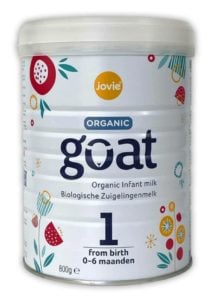
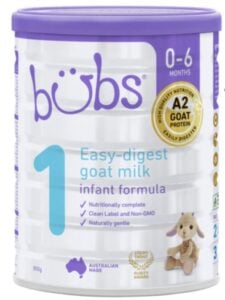
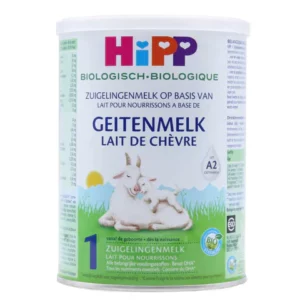
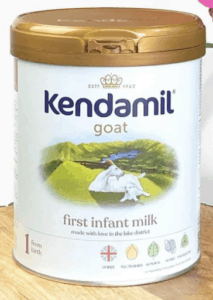
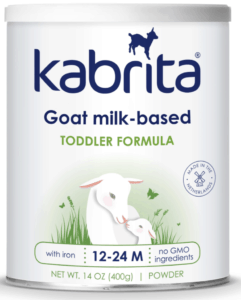




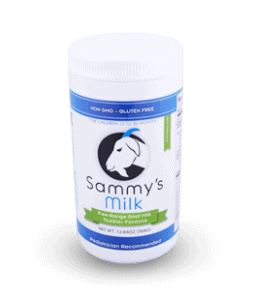


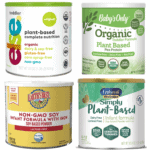













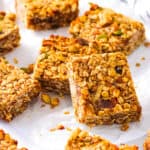




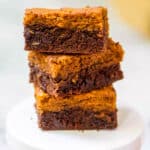



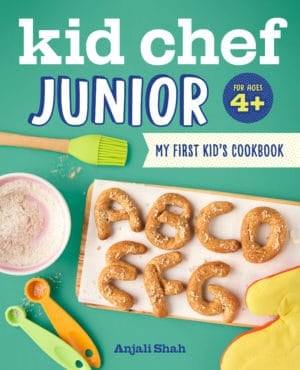

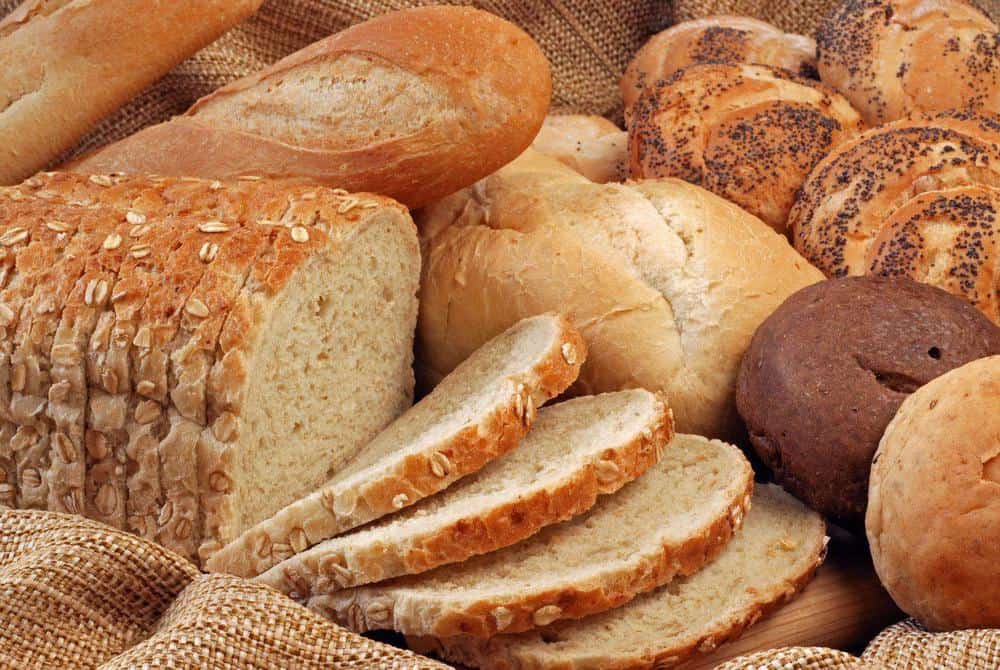
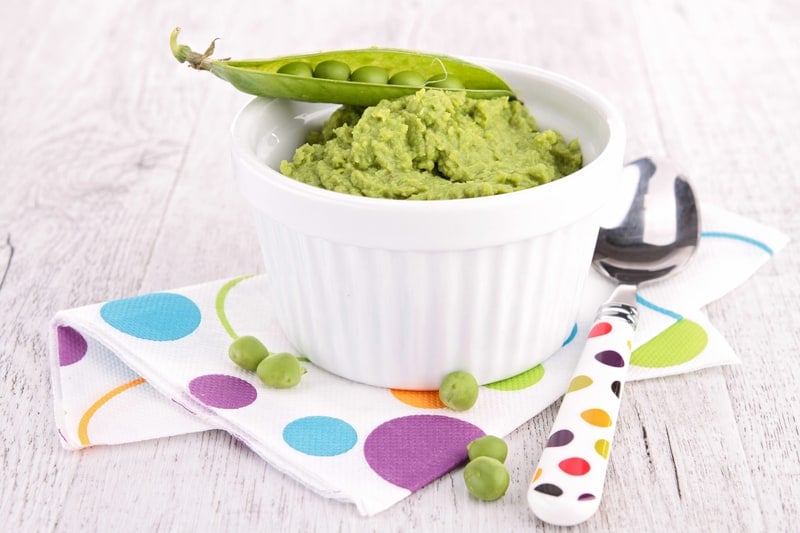
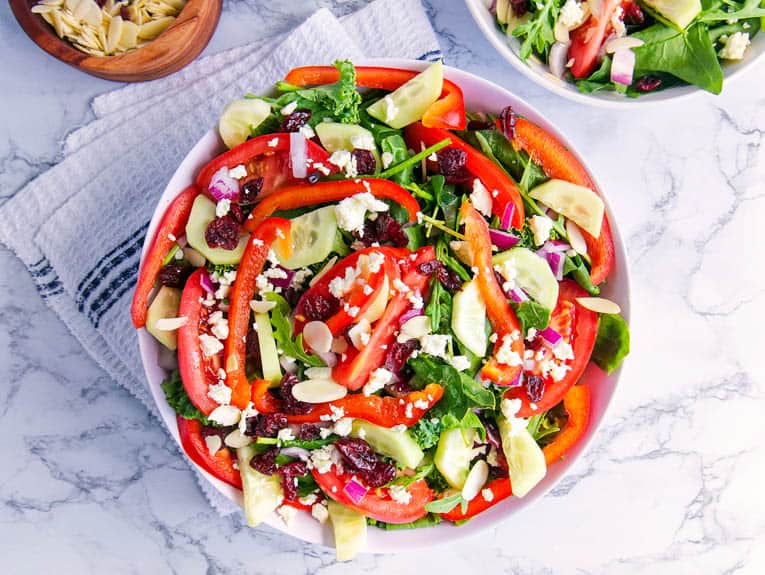


Can I give kabrita goat milk to my my 6 month old. Please reply
Hi! Technically, Kabrita USA is a toddler formula, but it meets the nutritional requirements for an infant formula. So as long as your pediatrician is ok with it, you can give it to your 6 month old! I know lots of moms who use it for their infants with no issues so just check with your pediatrician before starting it!
Hello, I saw on the Kabrita USA site that the toddler formula should be used to wean or supplement with breast milk but in my case I will only be feeding my 2 month old the toddler formula. Do you know if this would be enough? I compared the nutritional value of his current formula to the Kabrita toddler formula and they are similar, however Kabrita has Folate instead of folic acid. Thank you in advance!
Hi Laura! Kabrita USA meets the nutritional requirements for an infant formula, so technically it should be ok for your 2 month old! But before starting your 2 month old on Kabrita USA, make sure your pediatrician is both aware of it and approves the formula for your baby. Folate and folic acid are basically equivalent from a nutritional standpoint, as long as your baby doesn’t have an MTHFR mutation. Hope that helps!
Hi Anjali
I am looking to give (supplement) my newborn with Kabrita toddler formula (for my first baby I was able to obtain Kabrita Infant) and I noticed that the Kabrita Toddler has Folic Acid listed in the ingredients list (usually listed as an ingredient means synthetic folic acid)..however they have “Folate (Folic acid)” listed in Nutritional guide. I am wanting to be sure it is food-based Folate and not synthetic folic acid.
Thank you for all your wonderful information!
Hi Stephanie! I’m pretty sure Kabrita uses folic acid, not food-based folate in their formula. I believe it’s actually required by the FDA to use folic acid (not folate or methylated folate) in infant formula. You can read more about why here: https://kabritausa.com/blogs/nourish-blog/behind-the-label-folic-acid#:~:text=Kabrita%20Goat%20Milk%20Formula%20is,folate%20to%20meet%20their%20needs. Hope that helps!
Hi. Does Nanny Care 1 have fluoride? Also, what DHA/probiotic do you recommend? Thanks
Hi Tanya! NannyCare doesn’t have added fluoride. I like this DHA from Nordic Naturals and this probiotic from Garden of Life. Hope that helps!
Why I was wondering about the fluoride is because it is on the list of ingredients. Do you know why that would be?
Thank you 🙂
Hi Tanya! European formulas list fluoride on the ingredients because they’re taking into account the fluoride in the water that the formula is mixed with 🙂
Hi! Have you heard of Kabrita Dutch formula? What do you think of it?
Hi Tanya! Do you mean Kabrita Infant formula made in the Netherlands? I don’t recommend that formula because it includes glucose syrup solids among other more processed ingredients. Hope that helps!
Hello,
Thank you very much for the breakdown. Why is skim milk the preferred option and not whole milk?
Hi Leyla! Whole milk is actually a great option – just as good as skimmed milk! Very few formulas will use whole milk, which is probably why in my chart I noted skimmed milk but not whole milk — but either are really ok 🙂 Hope that helps!
Hi. Thank you so much for your informative posts!
For babies with reflux which one is better – Kabrita or Holle Goat?
Or do you recommend something else?
Hi Lia! For babies with reflux (and not an allergy), I actually have heard that HiPP AR works really well – since it is formulated especially for reflux! Hope that helps!
Hi! Any thoughts on Designed by Nature goat milk formula?
Thanks!
Oh wow – I didn’t know about their formula but it actually looks awesome! I think it would be a fine choice!
Do you know the whey/caesin ratio for this one?
Do you mean for HiPP Dutch? It’s the same as breastmilk!
Hi, I currently have my daughter on Holle Goat and she is Constipated. Could you please review a new Goat formula called Little Oak which is from New Zealand. Would really appreciate it.
Hi Kristina! Little Oak looks like a pretty great formula! It’s not certified organic, but the company claims to use organic farming practices for their ingredients (and just hasn’t taken the step to get certified yet). The ingredients look really clean and healthy. The one thing to keep in mind though, is the whey casein ratio of Little Oak’s formula is way off compared to breastmilk. Breastmilk is 60% whey, 40% casein. Little Oak’s formula is 20% whey, 80% casein – the same as Holle Goat — and this is the reason why Holle Goat constipates some babies. So given that your baby is having issues on Holle Goat she might have the same issue with Little Oak as well! You might want to try a cow’s milk formula like HiPP Dutch if she is not sensitive to cow’s milk proteins as an alternative. Hope that helps!
Hello,
I have heard that a1 milk which is most cow milk causes inflammation and that is a other reason people prefer it. My little one has been on hipp dutch for 1 month after breath feeding and seems to be doing well with occasional gas and spit up. Is it worth trying kabrita or do you feel having organic is more important than having A2 milk over A1 milk.
Hi Candice! It’s true that A2 milk is supposed to be easier to digest and is more similar to breastmilk proteins in its structure – but if your baby is already doing well on HiPP Dutch I wouldn’t switch! I think organic is more important than having A2 vs. A1 milk, for babies that are already doing well on A1 milk. Hope that helps!
Hi Anjali- my baby has a soy intolerance- so would you say I should not choose Kabrita as it has soy oil and try Holle instead? Thanks!
Hi Sarina! Yes if your baby can’t tolerate soy, and you need a goat milk formula, then go with Holle Goat. If your baby doesn’t need a goat milk formula, I’d recommend getting HiPP Dutch. Hope that helps!
Hi!! I really like Mt. Capra goat milk what do you think for an infant?
Hi Tammy! Are you talking about the Mt. Capra homemade goat milk formula recipe? The ingredients look good to me in that recipe, but I’ve never tried it so I can’t vouch for it personally. That said, if your pediatrician is supportive of you making the goat milk formula at home and giving it to your infant you should be fine to try it!
Hi there, Do Kabrita USA do a formula for newborns? I can only see formula for 12 months and up on their website…
Hi Fiona! Kabrita USA doesn’t currently have an infant branded formula. That being said, their current formula (which is labeled as a toddler formula) meets the nutritional requirements for infants – so as long as your pediatrician is ok with you using it for your baby – it should be fine!
Hello Anjali, thank you for the posts. Great help! Great web page!
Question: do you know a French goat milk named Lactichevre?
Dou you think it is any similar to Kabrita or Holle? (those are the only ones available in Chile)
Thank you!
Hi Julia! It looks like Lactichevre is similar to Holle from an ingredients standpoint — because it’s made with milk and lactose as the primary carbohydrates but it also includes maltodextrin. I don’t think it has pre/probiotics or DHA/ARA added either (similar to Holle). But I don’t know if Lactichevre is organic – I couldn’t tell from the labeling, so that is something to keep in mind if you use it!
Thank Anjali!
Huggs!
No problem at all! 🙂
My doctor is concerned about The amount folate For infants, I have 10 week old. Is this the same as folic acid? I don’t see folate listed anywhere and I can’t find the liquid drops he is recommending I add. Thank you
Hi Jessica! Folate and folic acid are equivalent — folate is what’s found in food, while folic acid is “synthetic” in that it can be made in a lab. Folate is only needed for babies or kids with MTHFR mutations because their bodies can’t process folic acid. But if your formula has folic acid, and your baby doesn’t have the mutation – you should be fine. You should follow up with your doctor about this though to make sure you’re not misunderstanding why he’s recommending folate drops for your baby!
Thank you for this info. I keep going back and forth between Nannycare and kabrita. I thought soybean and palm oil isn’t good to have in formula and kabrita has that? Nanycare doesn’t so why is nannycare not up there? Just curious.
And my little one is only 2 months old. Will I be able to use this formula when she’s so young?
Hi Suzy! The palm oil in Kabrita is actually not the problematic palm oil that is in most formulas. You can read more about the palmitic oil in Kabrita here. Kabrita is also non-GMO, while NannyCare is not. Kabrita does have soy oil — but it’s basically a trade off between having soy oil but having no other synthetic ingredients + being non GMO, and no soy oil but a couple of synthetic ingredients and no non-GMO or organic certifications. Kabrita also seems to be gentler on babies tummies since it has a whey:casein ratio closer to breastmilk. It is marketed as a toddler formula but meets the nutritional requirements for infants, so as long as your pediatrician is ok with it, you should be able to give it to your baby. I would just check with your peds first. Hope that helps!
What are your thoughts on formula allergy causing eczema? Cow’s milk protein. My baby is 5 months old and we have done everything we possibly can re trying to get rid of possible culprit except change his formula (similac lactose sensitive)
Hi Nina! Some babies can’t even tolerate “sensitive” formulas because their milk protein allergy is that severe/sensitive. I’d recommend trying two things: 1) try a hypoallergenic formula and 2) Use these natural remedies for eczema along with the formula change! Hope that helps and hope your baby gets some relief soon!
Hi Anjali! Similar to what someone else asked before, do I have to worry about Kabrita USA containing soybean oil and it causing inflammation on my toddler?
Also, any recommendations on how much to feed toddler (She’s a pretty good eater most of the time)…I’m in the process of weaning her off so wanted to offer her formula to help with the process? Thank you so much for your help.
Hi Marielle! While soybean oil isn’t ideal, the alternative is Holle Goat which has maltodextrin (which also causes inflammation and is high-glycemic), and has a whey-casein ratio that doesn’t mimic breastmilk so it can constipate some toddlers. If you’re going with Goat Milk formula, no formula is going to be perfect so I’d say KabritaUSA is about as good as it’s going to get! As for how much to feed her, I would really ask your pediatrician about that because all toddlers are different — some will have 2-3 8oz bottles of either whole milk or formula a day, some will have much less and will eat more yogurt, cheese etc. So I would ask your pediatrician what they recommend in terms of amount of formula! You can also ask them if your toddler is ready to transition to organic whole milk instead of formula as that can be an option too!
I’ve noticed that in the comments you’ve explained several times that even though Kabrita is marketed for toddlers it can be used for infants. But also in a reply you made to someone you listed their disclaimer that Says Kabrita shouldn’t be used as a main source of nutrition, but rather for weaning and supplementing. I do plan to use it to supplement as I’m pregnant and I think my supply is dropping for my almost 6mo. My question is, if I completely dry up is this not a formula that I can use alone and full time for my baby?
Hi Kelsey! Kabrita has that disclaimer because they want to encourage breastfeeding for the first year of life. But nutritionally, it should be fine to use full time as long as your pediatrician is ok with it! Hope that helps!